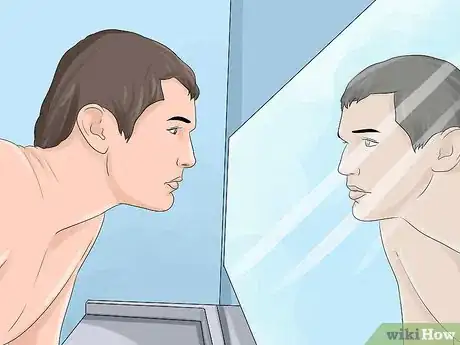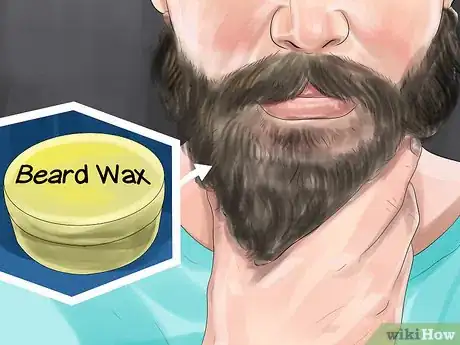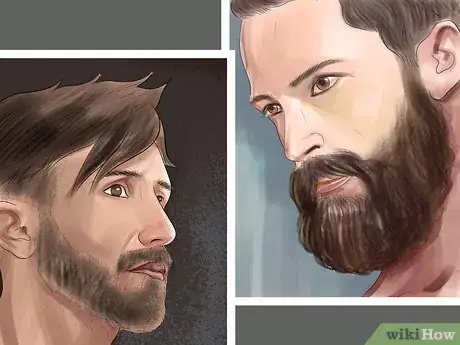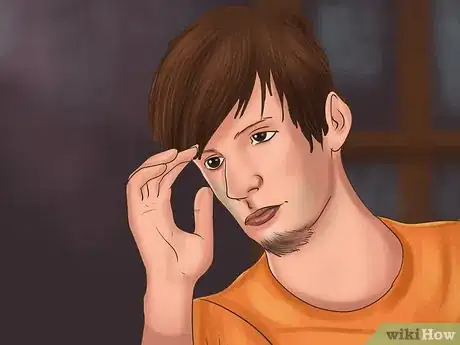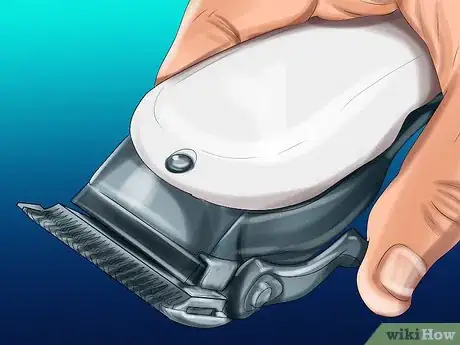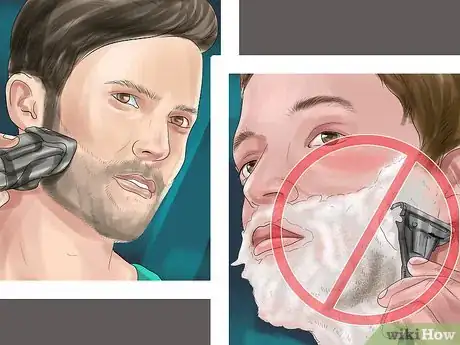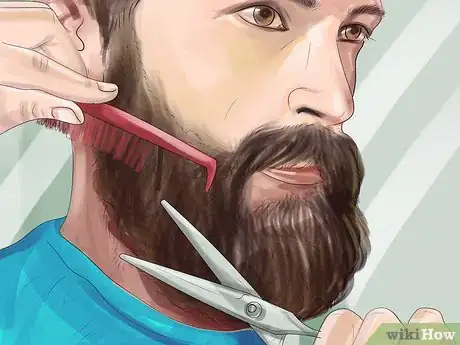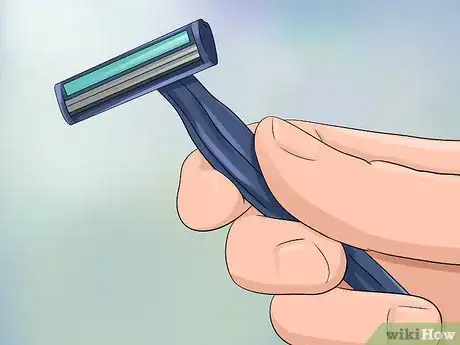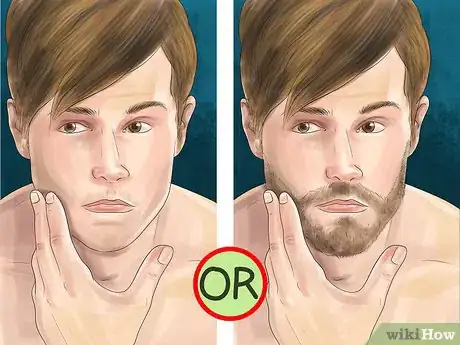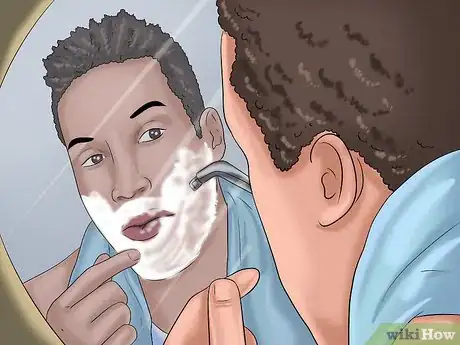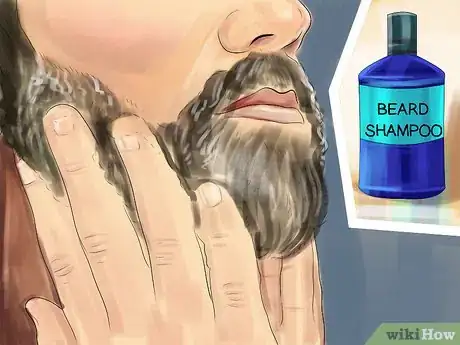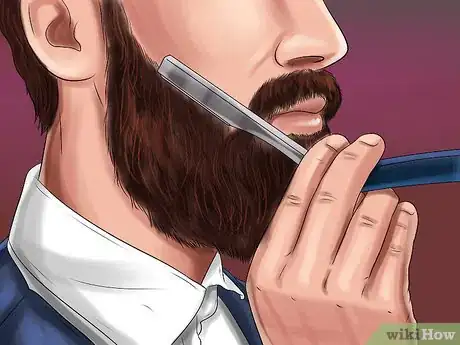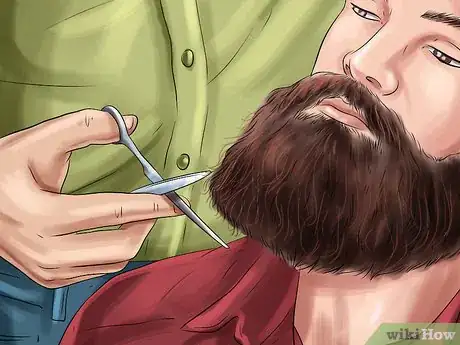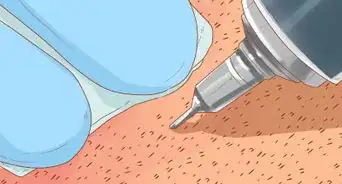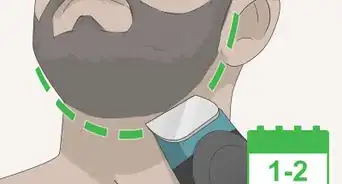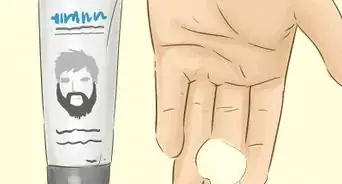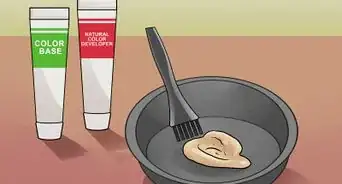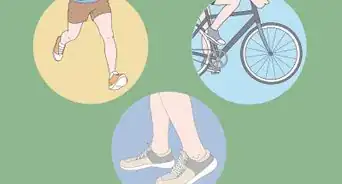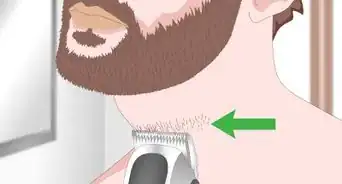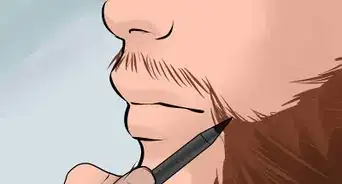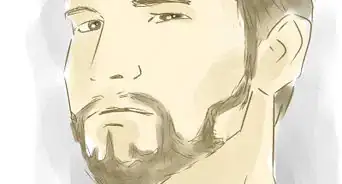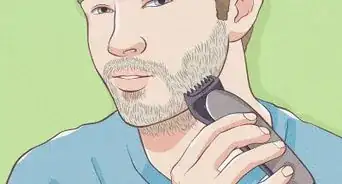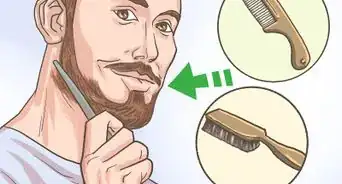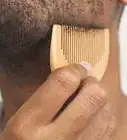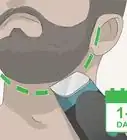This article was co-authored by Timmy Yanchun. Timmy Yanchun is a Professional Barber and Co-Founder of Svelte Barbershop + Essentials. Svelte Barbershop + Essentials is a men’s grooming company, specializing in men’s hair, beard, skin, and shave products, originally located in the SLS Hotel in Beverly Hills, California but has now branched out to 3 locations across Los Angeles. Timmy has been cutting hair since age 13 and opened his first of 6 barbershops at age 18. He is also the co-founder of the newly launched brand LTHR, the world's first wireless hot lather machine for barber quality shaves at home. Timmy and Svelte have been featured in GQ, Men's Fitness, and Hypebeast.
There are 16 references cited in this article, which can be found at the bottom of the page.
This article has been viewed 253,135 times.
A full, luxurious beard makes an immediate statement. But if it’s not properly groomed, it may not be the one you want. Fear not—there are a few simple tricks you can draw on to help you figure out how best to wear your facial hair. A beard shape that offsets or accentuates your facial features will help create a look that's both masculine and mature. Once you've decided on a suitable style, you can maintain it by keeping it trimmed to a neat length and periodically touching up key areas like your sideburns, neckline, and cheeks.
Steps
Choosing a Complementary Shape
-
1Identify your natural face shape. Take a look in the mirror and note what stands out to you. Do you have a chiseled jawline, or do your cheeks protrude slightly? Is your head a perfect oval or something that more closely resembles an inverted pyramid? Do a little creative visualization to determine what changes would be needed to achieve a more proportionate appearance.[1]
- If you really want to do your homework, measure your forehead, cheekbones, jawline, and find the distance between your crown and chin. The longest measurements will be an indicator of how your head and face are structured.[2]
- Zeroing in on the ideal beard style is largely a matter of knowing which features to highlight and which to draw attention away from.
- Regardless of your face shape, a beard can help balance out your nose, draw attention to your eyes, and make your chin look more defined.
-
2Wear your beard longer to offset a round or blocky head. Crop the growth on your cheeks and sideburns closer to the skin and let the hair gradually get longer as it reaches your chin. A sleek taper will have a lengthening effect that makes each of your features appear more evenly balanced.[3]
- A small amount of beard oil or a low-hold pomade will help you maintain your carefully-crafted beard shape throughout the day.
Advertisement -
3Keep your beard bushy on the sides to fill out a thin, angular face. Some men have the opposite problem—a long, slender head shape that a pointy beard only exaggerates. If you’re one of these men, you can trim the hair on the tip of your chin to do away with excess length, but leave the thickest tufts around the cheeks and sideburns intact. This will add some volume around the sides of your face.[4]
- Your goal should be to sculpt a smooth, subtle curvature of the jawline.
- Be careful not to let your beard grow out too much on the sides, or it may push your face shape too far in the other direction.
-
4Draw on more unique styles to hide thin, patchy areas. If your mustache doesn’t quite grow into your chin hair, you might dispense with it altogether and go for a swashbuckling style beard with a disconnected mustache and soul patch. Similarly, a no-man's-land between your goatee and the hair on your cheeks can be dealt with by deliberately leaving a strip of extra space on either side of your mouth.[5]
- Just because your facial hair isn’t thick and full all the way around doesn’t mean you can’t make what’s there work in your favor.
Trimming Your Beard
-
1Comb out your beard. Run a fine-toothed beard comb or small hairbrush with flexible bristles through your facial hair from cheek to chin. Stroke the hair outward, away from your face, so that it all stands up in one direction. This will give you a better sense of how long your beard actually is and also make it easier to prune without making costly mistakes.[6]
- Daily combing is necessary to identify areas that need trimming, prevent tangles, and redistribute natural oils.
- Keeping your beard brushed out is also a useful way to create the appearance of added volume, since it gets the hairs fluffed up nicely.
-
2Use a beard trimmer to control how much you take off.[7] Glide the head of the trimmer over your face slowly, using light pressure. If your goal is to thin out a bushy beard, use upward strokes, so that the blades of the trimmer cut square across the hairs. If you'd rather preserve more of the bulk you've been so committed to growing, move the trimmer downward in the same direction that the hair lays naturally.[8]
- Set the guard to about a 3 initially (which is usually somewhere around 9mm) and switch to a lower setting if you want to go shorter. That way, you can avoid accidentally shaving too much at once.[9]
- Beard trimmers offer a more customizable trimming experience because of their ability to cut hair to a consistent length with every pass, unlike scissors, which force you hack away at tufts piece by piece.
-
3Work from the outside in. Start by buzzing both cheeks until you strike the desired balance between volume and tidiness. Once the sides look good, move the trimmer inward and go over your chin and mustache area. Double check that both sections are equally full, and that both halves of your face match.[10]
- Most men's facial hair tends to be thicker around the goatee, so starting with the cheeks helps ensure that your beard comes out even without having to go shorter on the sides than you'd like.
-
4Create transition with your sideburns. Sideburns are tricky, since they can be treated as either an extension of your beard or your head hair. Assuming that your head hair and facial hair are approximately the same length, you can let what's up top flow seamlessly into what's underneath. If one is significantly longer than the other, try fading your sideburns using increasingly smaller guards so that the difference isn't too jarring.[11]
- For extremely short hairstyles like buzz cuts and shiny bald domes, blend your sideburns until they disappear around the top of your ear.[12]
- Longer locks are a little simpler. Just keep your sideburns clean and neat, then leave everything above and below your ears as shaggy as you please.
Structuring Your Neckline
-
1Place two fingers just above your Adam’s apple. Hold the fingers sideways, so that they lay across your throat. This is the sweet spot where you should begin your neckline. You’ll be leaving just enough growth beneath your jaw to ensure a natural transition without letting it get out of control.[13]
- If you’re having trouble finding the exact point, feel for the rigid lump in your windpipe, then slide your fingers up until they rest in the little groove at the top.
- Most stylists recommend that a beard should terminate about 1–1.5 inches (2.5–3.8 cm) above the midpoint of your neck.[14]
-
2Shave all the hair below your upper finger. Take a mental snapshot of the exact point, or make a small mark with your clippers to serve as a reference. Shear off the beard’s lower extremities so that it forms one clean line straight across.[15]
- Your neckline is every bit as important as the rest of your facial hair. A sloppy-looking neckbeard can sabotage an otherwise sophisticated style.
-
3Shape your neckline in a gentle curve from ear to ear. Now it’s time to apply the finishing touches. Picture an imaginary line running beneath your chin in a shallow “U” shape. Using your clippers, chip away at the remaining hair on both sides of your Adam’s apple. When you’re finished, your neckline should roughly mirror the shape of your jaw.[16]
- Be careful not to start your neckline too high up. A lower jaw that’s completely hairless can make your beard look like it lacks coverage.[17]
-
4Remove any remaining stubble with a manual razor. Go back over the area you just buzzed to cut the coarse hair down to the skin. Not only will this leave your neckline looking pristine, it will also keep unwanted growth from returning quite so fast.
- To prevent irritating razor burn, lather up with moisturizing shave gel and make your strokes with the grain, not against it.[18]
Keeping Your Beard Neatly Groomed
-
1Wash and dry your beard before shaping it up. Use shampoo and conditioner to clean and soften your facial hair regularly.[19] After showering, hold off on trimming or styling until your beard has had time to fully dry and reassume its original form. This is when it will be most manageable, as it will have a little extra volume and look like it will when you’re out walking around.
- A few passes with a blowdryer on a low heat setting can help speed up the drying time.
- Attempting to shape a wet, limp beard is risky because the hairs will draw up and change shape as they dry.[20]
-
2Clean up the lines of your cheeks. Guide your clippers along the upper perimeter of your beard to get rid of fuzzy overgrown edges. Ideally, your facial hair should be just as thick at the top as it is at the bottom instead of becoming sparse and fading away. The same rules apply even if you decide to trim it down nearer to your jawline.[21]
- Generally, it’s best not to let your beard climb any higher than the points of your cheeks. It may help to visualize a line running from the top of your mustache to your sideburns.
- When it comes time to manicure the top half of your beard, you’ll want to follow your natural contours rather than choosing an approximate stopping point like you did with your neckline.
-
3Trim stray hairs to an even length. Use a pair of scissors to snip any scraggly or overly-long strands that have managed to escape your clippers.[22] Tilt your head at different angles so you can more easily see hairs that are sticking out. Each part of your facial hair should be a uniform length.[23]
- Gently tease out longer sections with a comb to make them easier to clip.
- It’s perfectly acceptable to have a mustache or goatee that’s longer than the rest of your beard, as long as these sections are a consistent length.
Our Most Loved Articles & Quizzes
Expert Q&A
Did you know you can get expert answers for this article?
Unlock expert answers by supporting wikiHow
-
QuestionHow do I trim and shape my beard?
 Laura MartinLaura Martin is a Licensed Cosmetologist in Georgia. She has been a hair stylist since 2007 and a cosmetology teacher since 2013.
Laura MartinLaura Martin is a Licensed Cosmetologist in Georgia. She has been a hair stylist since 2007 and a cosmetology teacher since 2013.
Licensed Cosmetologist
-
QuestionWhere should my beard line be?
 Laura MartinLaura Martin is a Licensed Cosmetologist in Georgia. She has been a hair stylist since 2007 and a cosmetology teacher since 2013.
Laura MartinLaura Martin is a Licensed Cosmetologist in Georgia. She has been a hair stylist since 2007 and a cosmetology teacher since 2013.
Licensed Cosmetologist
-
QuestionHow do you trim facial hair?
 Laura MartinLaura Martin is a Licensed Cosmetologist in Georgia. She has been a hair stylist since 2007 and a cosmetology teacher since 2013.
Laura MartinLaura Martin is a Licensed Cosmetologist in Georgia. She has been a hair stylist since 2007 and a cosmetology teacher since 2013.
Licensed Cosmetologist
Warnings
- Shave cautiously to avoid nicks, scrapes, and other mishaps.⧼thumbs_response⧽
- If you end up taking too much off, there may be no way to salvage it but to shave it off and start over.⧼thumbs_response⧽
Things You'll Need
- Beard trimmer or electric shaver
- Manual razor
- Scissors
- Shampoo and conditioner
- Hairdryer
- Beard oil or conditioning cream (optional)
- Ruler (for taking facial measurements)
References
- ↑ https://manofmany.com/fashion/grooming/how-to-pick-beard-suit-face-shape
- ↑ http://www.fashionbeans.com/2017/how-to-determine-your-face-shape/
- ↑ http://www.fashionbeans.com/2017/right-beard-for-your-face-shape/
- ↑ http://www.businessinsider.com/the-best-beard-style-for-every-face-shape-2017-2/#-6
- ↑ https://www.gq.com/story/how-to-shape-your-beard-like-a-pro
- ↑ https://manlinesskit.com/how-to-groom-a-beard-as-it-grows/
- ↑ Timmy Yanchun. Professional Barber. Expert Interview. 22 January 2020.
- ↑ https://www.youtube.com/watch?v=Z3epFceKvNw&feature=youtu.be&t=38
- ↑ https://www.gq.com/story/beard-package-facial-hair-shaving-trimming
- ↑ http://beardtrimandgroom.com/how-to-trim-a-beard-with-a-trimmer/
- ↑ https://theidleman.com/manual/life/grooming/how-to-achieve-the-perfect-faded-beard-shape-up/
- ↑ https://theidleman.com/manual/life/grooming/how-to-achieve-the-perfect-faded-beard-shape-up/
- ↑ http://beardoholic.com/beard-neckline/
- ↑ https://www.themanual.com/grooming/how-to-shape-a-beard/
- ↑ https://ruggedfellowsguide.com/trimming-a-beard-neckline/
- ↑ https://ruggedfellowsguide.com/trimming-a-beard-neckline/
- ↑ https://www.themanual.com/grooming/how-to-shape-a-beard/
- ↑ https://www.aad.org/public/everyday-care/skin-care-basics/hair/how-to-shave
- ↑ Timmy Yanchun. Professional Barber. Expert Interview. 22 January 2020.
- ↑ https://manlinesskit.com/how-to-groom-a-beard-as-it-grows/
- ↑ https://www.themanual.com/grooming/how-to-shape-a-beard/
- ↑ Timmy Yanchun. Professional Barber. Expert Interview. 22 January 2020.
- ↑ http://www.mensjournal.com/health-fitness/grooming/how-to-tame-a-wild-beard-20151005
About This Article
To shape your beard at home, begin by choosing the right shape to suit your face. For example, a longer beard can offset a round face and a bushy beard can bulk up a thin face. Then comb your beard, stroking each hair outward, away from your face. Using a beard trimmer set to 3, work from the outside edges of your beard toward the center of your face, being careful to keep your trimming symmetrical and blend your beard into your sideburns. When you're done, use a razor to remove any remaining stubble. To learn more from our Cosmetologist co-author, like how to clean up cheek lines and products to use on your beard, keep reading the article!
